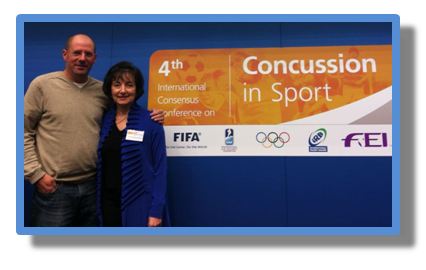On November 1 and 2, 2012, I attended the 4th International Consensus Conference on Concussion in Sport, held in Zurich, Switzerland at the headquarters of the Federatione Internationale de Football Association (FIFA), soccer's world governing body.

The Zurich conference was the latest in a quadrennial series (Vienna 2000, Prague 2004, and Zurich 20081) attracting prominent sports concussion experts around the world to review and discuss the most recent findings and research. Out of the conference will come a Fourth Consensus Statement on Concussion in Sport updating the guidelines for identification, treatment, and management of sports concussion, expected to be issued in the spring of 2013.
The Conference organizers included the International Olympic Committee, International Rugby Board, International Ice Hockey Federation, Federation Equestre Internationale, and the host, FIFA. The USA was well-represented by numerous speakers, including, among others, Dr. Robert Cantu and Dr. Ann McKee from Boston University's Center for the Study of Traumatic Encephalopathy, Dr. Mike Stuart from USA Hockey, Dr. Stan Herring, a major legislative advocate for sports concussion, and Dr. Margot Putukian, the chair of the US Lacrosse Sports Science & Safety Committee and of the NFL Return to Play Subcommittee.
Key points
As a sports concussion neuropsychologist, here is what I took away from the Zurich conference:
- One of the advantages of such an international forum is that it makes it easier to view concussions in the larger context of sports. While concussions in the National Football League have garnered the lion's share of the media's attention in the United States, sports concussion is not just about the NFL. In fact, international equestrian sports, unfortunately, boasts the highest rates of head injury and concussion;
- Ever since US Olympic dressage rider Courtney King-Dye suffered a traumatic brain injury while training a horse in March 2010 (an accident which left her in a coma for a month and from which she has yet to fully recover), the focus in the equestrian world has been on the development and use of helmets (although there is pushback);
- The United States is far ahead of other countries in laws governing sports concussion, education and programs for youth sports.
- The understanding and management of concussion in very young athletes (under 10) has suffered from a lack of research and evidence-based guidelines. This is a problem, as the younger brain is more vulnerable, and this area needs much more focus.
- As in all areas of medicine, technology, such as smartphone applications, website interfacing, hit sensors, promises to greatly influence and enhance the identification and management of sports concussion;
- The international community has become increasingly skeptical of the science behind the Cantu/McKee Boston University CTE findings, noting the lack of experimental controls, possible bias in sampling, and suggesting that it is too early to jump to conclusions as to what their findings really mean;
- Little has been achieved in developing treatments for concussion and the persistent headaches which are its number one symptom;
- The debate continues to rage over whether introducing helmets into girls' contact sports, such as lacrosse, will help reduce the incidence of head injury or actually lead to an increase in concussion rates by giving athletes a false sense of protection and thereby increasing aggressive play. (Note: a new study2 finding no increase in concussion rates in states mandating protective eyewear in girl's field hockey suggests that protective equipment does not lead to more aggressive play);
- The international community seems to place a greater weight and importance on use of the Sport Concussion Assessment Tool Version 2 (SCAT2) - a sideline assessment tool introduced as part of the Consensus Statement issued after the 3rd International Conference on Concussion in Sport held in Zurich in 20081 - than in the United States, where, anecdotal evidence suggests, it is not in widespread use. The SCAT2 has not been adequately validated as a diagnostic tool, and I have personally found it to be of limited value in my clinical practice. In my professional opinion, if sideline personnel suspect that an athlete has sustained a concussion, they should send him or her to see a concussion specialist. Period. Performing a SCAT2 isn't needed to document that suspicion. Indeed, many of the athletic trainers with whom I work find the tool cumbersome and duplicative. Nevertheless, it is my understanding that the group charged with drafting the 4th consensus statement out of the Zurich conference plan to issue a SCAT3, and even develop a child's version, and possibly a version for coaches. Personally, I believe that the conference committee's time could be better spent on other areas of sports concussion that are in greater need of attention, and that coaches should not be trying to assess concussion on the sideline with a SCAT; and
- Finally, I was interested to see Dr. Grant Iverson's presentation on the value of rest as a treatment for concussion. Up until recently, there had been no published/researched evidence to support the recommendation for rest after concussion. I was gratified that Dr. Iverson mentioned in his remarks that the study which I published in the Journal of Pediatrics in June 20123 was the first scientific evidence to support the use of comprehensive rest and that he cited it as an "excellent" first study.
To view videos of some of the lectures at the Zurich conference, click here.
1. Consensus Statement on Concussion in Sport: the 3rd International Conference on Concussion in Sport held in Zurich, November 2008.Br. J. Sports Med. 2009:43:i76-i84
2. Kriz PK, Comstock RD, Zurakowski D, Almquist JL, Collins CL, d'Hemecourt PA. Effectiveness of Protective Eyewear in Reducing Eye Injuries Among High School Field Hockey Players. Pediatrics 2012;130(6):1069-1075.
3. Moser RS, Glatts C, Schatz P. Efficacy of Immediate and Delayed Cognitive and Physical Rest for Treatment of Sport-Related Concussion. J Pediatrics 2012; DOI: 10.1016/j.jpeds.2012.04.012 (in press).
Posted December 22, 2012








